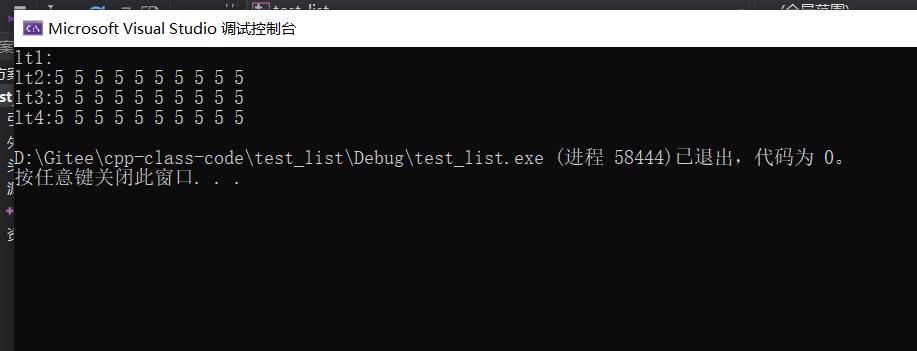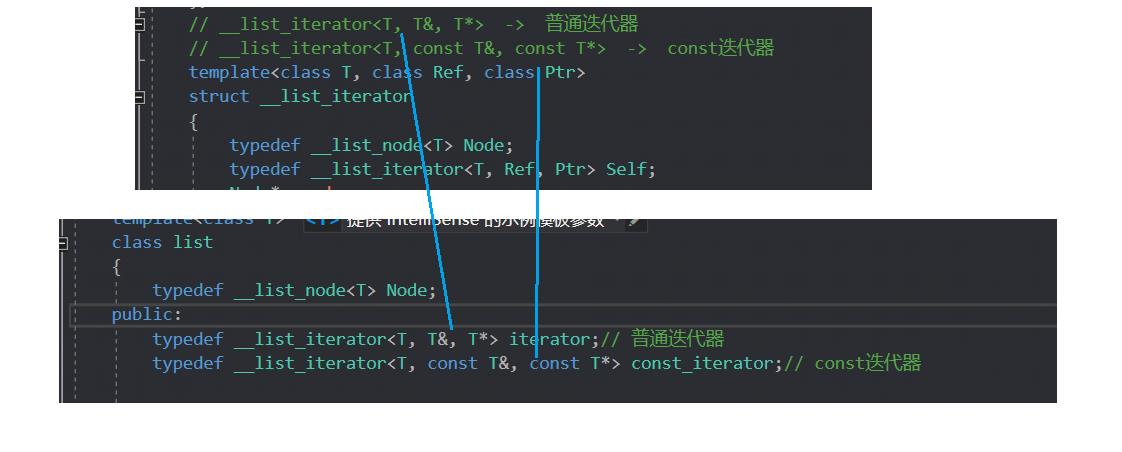C++初阶第十一篇——list(list常见接口的用法与介绍+list的模拟实现+list迭代器原理)
Posted 呆呆兽学编程
tags:
篇首语:本文由小常识网(cha138.com)小编为大家整理,主要介绍了C++初阶第十一篇——list(list常见接口的用法与介绍+list的模拟实现+list迭代器原理)相关的知识,希望对你有一定的参考价值。
⭐️这是年前的最后一篇博客,今天我先为大家介绍STL中的list容器,我会先介绍它的一些个常见接口以及用法,然后再模拟实现它,其中list的迭代器相比前两个容器的来说更为复杂,所以我会更加详细地介绍它,这样我们就能够比较深入地了解这个容器。
⭐️博客代码已上传至gitee:https://gitee.com/byte-binxin/cpp-class-code
目录
🌏list的介绍
list的本质是一个带头的双向循环链表。
总结几点:
- list是可以在常数范围内在任意位置进行插入和删除的序列式容器,并且该容器可以前后双向迭代。
- list的底层是双向链表结构,双向链表中每个元素存储在互不相关的独立节点中,在节点中通过指针指向其前一个元素和后一个元素。
- list与forward_list非常相似:最主要的不同在于forward_list是单链表,只能朝前迭代,已让其更简单高效。
- 与其他序列式容器相比,list和forward_list最大的缺陷是不支持任意位置的随机访问。
🌏list常见接口的介绍
🌲list的构造函数

- 无参构造: list()
- 用n个值为val的元素构造: list (size_type n, const value_type& val = value_type())
- 拷贝构造: list(const list& lt)
- 用一段区间的元素构造list: list (InputIterator first, InputIterator last)
实例演示
void TestList1()
list<int> lt1;// 无参构造
list<int> lt2(10, 5);// 用n个val构造一个list对象
list<int> lt3(lt2);// 拷贝构造
list<int> lt4(lt2.begin(), lt2.end());// 用一段区间的元素构造list
cout << "lt1:";
PrintList(lt1);
cout << "lt2:";
PrintList(lt2);
cout << "lt3:";
PrintList(lt3);
cout << "lt4:";
PrintList(lt4);
代码运行结果如下:

🌲list中迭代器
- .begin + end: 获取第一个数据位置的iterator/const_iterator, 获取最后一个数据的下一个位置
的iterator/const_iterator - rbegin + rend: 获取最后一个数据位置的reverse_iterator,获取第一个数据前一个位置的reverse_iterator

🌲list的迭代器遍历
实例演示
void TestList2()
list<int>lt;
lt.push_back(1);
lt.push_back(2);
lt.push_back(3);
lt.push_front(0);
lt.push_front(-1);
lt.push_front(-2);
list<int>::iterator it = lt.begin();
while (it != lt.end())
cout << *it << " ";
++it;
cout << endl;
for (auto e : lt)
cout << e << " ";
cout << endl;
list<int>::reverse_iterator rit = lt.rbegin();
while (rit != lt.rend())
cout << *rit << " ";
++rit;
cout << endl;
代码运行结果如下:

🌲list的增删查改

- push_back: 尾插
- pop_back: 尾删
- push_front: 头插
- pop_front: 头删
- insert: 在pos位置插入一个元素
- erase: 删去pos位置的一个元素
- swap: 交换两个list中的元素
- clear: 清理list的有效元素
实例演示
void TestList3()
list<int>lt;
lt.push_back(1);
lt.push_back(2);
lt.push_back(3);
lt.push_front(0);
lt.push_front(-1);
lt.push_front(-2);
cout << "删除前:";
PrintList(lt);
lt.erase(lt.begin());
cout << "删除后:";
PrintList(lt);
lt.insert(lt.begin(), 0);
cout << "插入一个数据后:";
PrintList(lt);
代码运行结果如下:

🌲list的大小和头尾元素的读取
- empty 判断容器是否为空
- size 获取容器有效节点的个数
- front 返回list的第一个节点的元素
- back 返回list的最后一个节点元素
🌏list迭代器失效
迭代器失效即迭代器所指向的节点的无效,即该节点被删除了。因为list的底层结构为带头结点的双向循环链表,因此在list中进行插入时是不会导致list的迭代器失效的,只有在删除时才会失效,并且失效的只是指向被删除节点的迭代器,其他迭代器不会受到影响。
两种情况测试
- 插入
void TestList4()
int arr[] = 1,2,3,4,5 ;
list<int> lt(arr, arr + sizeof(arr) / sizeof(arr[0]));
list<int>::iterator it = lt.begin();
lt.insert(it, 3);
代码运行结果如下:

- 删除
void TestList4()
int arr[] = 1,2,3,4,5 ;
list<int> lt(arr, arr + sizeof(arr) / sizeof(arr[0]));
list<int>::iterator it = lt.begin();
while (it != lt.end())
lt.erase(it);
++it;
代码运行结果如下:

总结: 插入数据不会导致迭代器失效,删除数据会导致迭代器失效。相比vector容器,vector容器插入数据是会导致迭代器失效,因为vector涉及增容问题,而list却不存在增容问题,所以迭代器指向的位置是有效的。删除数据会导致迭代器指向的位置是无效的,所以迭代器会失效。
修改后的代码如下:
void TestList4()
int arr[] = 1,2,3,4,5 ;
list<int> lt(arr, arr + sizeof(arr) / sizeof(arr[0]));
list<int>::iterator it = lt.begin();
//lt.insert(it, 3);
while (it != lt.end())
it = lt.erase(it);
🌏list的模拟实现
🍯list的整体框架
list是由节点组成,所以定义一个节点的类,然后list的类中成员只需要一个头结点的指针即可。
template<class T>
struct __list_node
__list_node<T>* _prev;
__list_node<T>* _next;
T _data;
__list_node(const T& x = T())
:_next(nullptr)
, _prev(nullptr)
, _data(x)
;
template<class T>
class list
typedef __list_node<T> Node;
public:
private:
Node* _head;
;
🍯list的构造函数
构造函数要做的任务就是开一个头结点,所以我们可以封装出一个具体的函数来实现创建头结点的这个过程。
创建头结点:
void CreatHead()
_head = new Node;
_head->_next = _head;
_head->_prev = _head;
构造函数的实现:
list()
CreatHead();
🍯list的迭代器的实现
list相比vector的迭代器而言,不再是一个简单的指针,它相对而言更复杂一些,list的迭代器为了实现一些简单的功能,我们把它封装成了一个类。看下面源码实现:

我们自己来模拟实现一下简单的。
迭代器的小框架(里面有一个成员变量——节点指针)
struct __list_iterator
typedef __list_node<T> Node;
__list_iterator(Node* node = nullptr)
:_node(node)
Node* _node;
由于迭代器分普通迭代器和const 迭代器,为了不造成代码冗余,我们设计出来三个模板参数,根据传入的模板参数确定是那种迭代器。
迭代器的实现
// __list_iterator<T, T&, T*> -> 普通迭代器
// __list_iterator<T, const T&, const T*> -> const迭代器
template<class T, class Ref, class Ptr>
struct __list_iterator
typedef __list_node<T> Node;
typedef __list_iterator<T, Ref, Ptr> Self;
Node* _node;
__list_iterator(Node* node = nullptr)
:_node(node)
__list_iterator(const Self& l)
:_node(l._node)
// *it T&
Ref operator*()
return _node->_data;
// it-> T*
Ptr operator->()
return &_node->_data;
Self& operator++()
_node = _node->_next;
return *this;
Self& operator--()
_node = _node->_prev;
return *this;
Self operator++(int)
Self tmp(*this);
//_node = _node->_next;
++(*this);
return tmp;
Self operator--(int)
Self tmp(*this);
//_node = _node->_prev;
--(*this);
return tmp;
Self operator+(int count)
Self tmp(*this);
while (count--)
++tmp;
return tmp;
Self operator-(int count)
Self tmp(*this);
while (count--)
--tmp;
return tmp;
bool operator!=(const Self& it)
return _node != it._node;
;
我们还要在list里面做这样一个操作(堆两种迭代器进行重命名,方便我们认识):
typedef __list_iterator<T, T&, T*> iterator;// 普通迭代器
typedef __list_iterator<T, const T&, const T*> const_iterator;// const迭代器
list内部begin()和end()的实现(普通迭代器调用前两个,const迭代器调用后两个)
iterator begin()
return iterator(_head->_next);
iterator end()
return iterator(_head);
const_iterator begin() const
return const_iterator(_head->_next);
const_iterator end() const
return const_iterator(_head);
🍯list的增删查改的实现
这里几个接口其实我们再之前数据结构的时候都实现过,比较简单
- push_back 这里的操作和我们之前数据结构中实现双链表的操作是一样的,我们只需要先开一个节点,然后再改变几个节点指针的指向就好了
void push_back(const T& x)
Node* newnode = new Node(x);
Node* tail = _head->_prev;
tail->_next = newnode;
newnode->_prev = tail;
newnode->_next = _head;
_head->_prev = newnode;
- pop_back
void pop_back()
assert(_head != _head->_next);
Node* tail = _head->_prev;
Node* prevTail = tail->_prev;
delete tail;
tail = prevTail;
tail->_next = _head;
_head->_prev = tail;
- push_front
void push_front(const T& x)
Node* newnode = new Node(x);
Node* firstNode = _head->_next;
_head->_next = newnode;
newnode->_prev = _head;
newnode->_next = firstNode;
firstNode->_prev = newnode;
- pop_front
void pop_front()
assert(_head->_next != _head);
Node* firstNode = _head->_next;
Node* secondNode = firstNode->_next;
delete firstNode;
firstNode = nullptr;
_head->_next = secondNode;
secondNode->_prev = _head;
- insert 在pos位置插入元素,首先要检测pos位置的有效性
void insert(iterator pos, const T& x)
Node* cur = pos._node;
Node* prev = cur->_prev;
Node* newnode = new Node(x);
prev->_next = newnode;
newnode->_prev = prev;
newnode->_next = cur;
cur->_prev = newnode;
注意,为了提高代码的复用性,push_front和push_back都可以复用insert
void push_back(const T& x)
insert(end(), x);
void push_front(const T& x)
insert(begin(), x);
- erase 删去pos位置的元素,同样要判断list是否为空
iterator erase(iterator pos)
assert(_head->_next != _head);
assert(pos != end());
Node* node = pos._node;
Node* prev = node->_prev;
Node* next = node->_next;
delete node;
node = nullptr;
prev->_next = next;
next->_prev = prev;
return iterator(next);
同样地,为了提高代码的复用性,pop_front和pop_back都可以复用erase
void pop_back()
erase(end() - 1);
void pop_front()
erase(begin());
- front 返回第一个节点的元素
T front()
assert(_head->_next != _head);
return _head->_next->_data;
- back 返回最后一个节点的元素
T back()
assert(_head->_next != _head);
return _head->_prev->_data;
🍯list中的析构函数和clear
- clear 通过迭代器遍历,一个一个的删除节点
void clear()
iterator it = begin();
while (it != end())
it = erase(it);
- 析构函数 可以先调用clear函数清理空间,然后再delete掉头结点
~list()
clear();
delete _head;
_head = nullptr;
🍯拷贝构造和operator=赋值重载
- 拷贝构造
list(const list<T>& lt) CreatHead(); /*const_iterator it = lt.begin(); while (it != lt.end()) push_back(*it); ++it; */ for (auto e : lt) push_back(e);以上是关于C++初阶第十一篇——list(list常见接口的用法与介绍+list的模拟实现+list迭代器原理)的主要内容,如果未能解决你的问题,请参考以下文章C++初阶第十二篇—stack和queue(stack和queue的常见接口的用法与介绍+priority_queue+容器适配器+仿函数+模拟实现)
C++初阶第九篇——string类(string类中一些常见接口的用法与介绍+string类的模拟实现)
C++初阶第一篇——初始C++(命名空间+缺省参数+函数重载)
